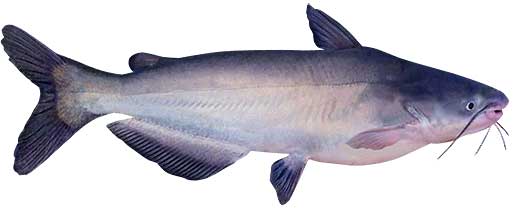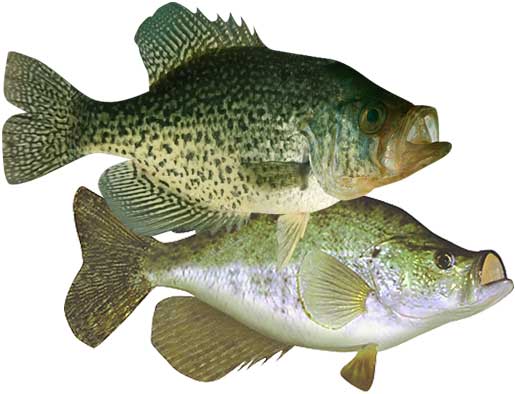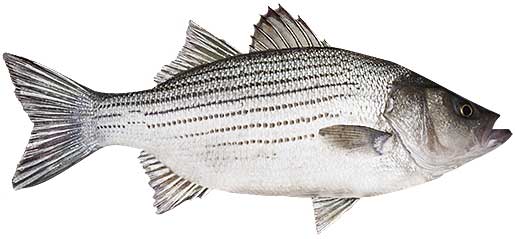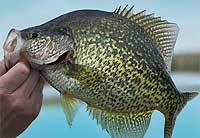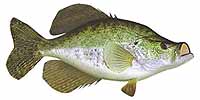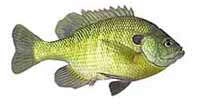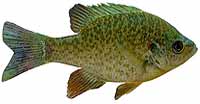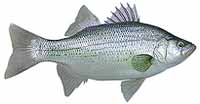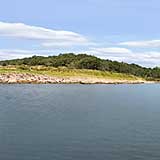Fishing Report For Kaw Lake, OK
By Rick Seaman
August 18, 2025
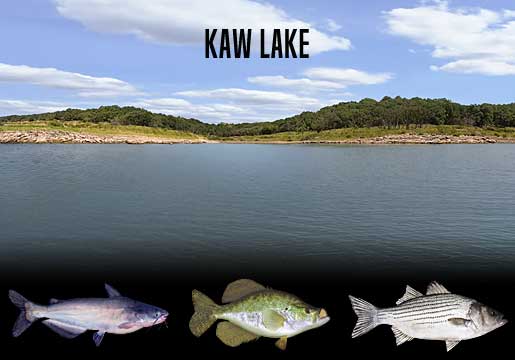
Fishing Reports
Popular Fish Species Kaw Lake, OK
Blue Catfish

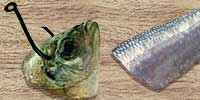
Current Report: Good To Very Good
SUMMER. Early Summer was post-spawn season for big blue catfish, now they follow big schools of baitfish, and feed heartily. They are located in 15 to 40 feet of water during the day, moving up to 15 feet and shallower during the night. Live bait is the preferred approach at night, while cut bait is also catching nice blues during the day. Stay around channel edges and fish areas that have concentrations of bait. Once Summer weather has warmed lake water above the 70's, blue catfish move closer to the main lake, to deeper feeding areas. Blues, including some of the bigger ones, are now being caught while slow trolling, or drifting ledges, adjacent to river channels, or within the channel along the edges. The lake record here is over 75 pounds, and big blues, 25 to 40 pounds, are regularly caught. Anglers fishing from the bank are catching a few fish, but boats are the preferred approach. Late Summer, if the water temperature rises above the high 70's, they become less active, and fishing can slow down.
FALL. Fall begins the aggressive feeding in preparation for winter. Blues at this time are being caught in bays, in and around creek channels, on flats, and along bends in the Arkansas Rover Channel, often toward the river end again. This is the time to catch a trophy, as they have been feeding heartily since early Spring.
WINTER. In Winter, focus on deep holes, in 25 to 60 feet deep, where blue catfish wait through the cold water season. They are less aggressive now, but slow drifting, or dead sticking cut shad, can still trigger bites. During Winter, these big fish school together in holes, or around bends, humps, or submerged timber. Use slip sinkers, 3-way rigs, or Carolina rigs with enough weight to keep the bait bumping bottom as you drift.
SPRING. Spring begins the aggressive feeding in preparation for winter. Blues at this time are being caught 5 to 15 feet deep in bays, on flats where baitfish school, and shallow ledges. Cut bait is the ideal bait this time of year, with locals preferring cut gizzard shad.
Black & White Crappie
Current Report: Good To Very Good
SUMMER. Water temperatures are currently in the mid to high 70's, and crappie fishing has been good for anglers finding them in 15 to 30 feet deep. Now that the spawn is over, and the hot Summer sun is warming the shallows, crappie have retreated to deep cover of standing timber, brush piles and channel edges along bends in the Arkansas River Channel. Vertical jigging with small spoons, jigs tipped with minnows, or heavy crappie jigs is catching some nice slabs.
FALL. Baitfish, which will be moving into shallow flats, coves and bays, will draw crappie into these areas, where they will feed heavily in 6 to 15 feet of water, preparing for the coming cold Winter. Small spoons, along with minnows, hair jigs, and crappie jigs, are good options during this feeding marathon. Slow trolling, especially while spider rigging, can load the boat with these active crappie.
WINTER. Once the shallows start cooling rapidly, crappie will migrate to deeper holding areas, mostly off shore. At this time they are typically caught using a very slow presentation, in 20 to 40 feet of water. The channel edges along bends in the Arkansas River Channel often hold big schools, and it can be the best time of year, once you locate a school. Good electronics improve your odds considerably. If they are suspending in open water, they often relate to some cover, or structure change, directly below them.
SPRING. In early Spring, crappie begin staging in 8 to 12 feet of water, just outside shallow spawning bays and flats. Spring is the ideal time to be on the water, as crappie have moved shallow to spawn. In April active spawning begins near shoreline cover, willow growth and rip rap. After spawning, they are typically caught in 5 to 10 feet of water. Docks, brush, wood and vegetation are where most anglers are catching good numbers using small crappie jigs or live minnows. After the spawn, crappie move outside the spawning area and typically hold deeper on the closest cover. Once they move off the beds, anglers are reporting good success using fish finders and forward facing sonar to locate schools of crappie, which tend to stack vertically around cover. Light tackle with 4 lb to 8 lb line is a popular choice.
Hybrid Striped Bass
Current Report: Fair To Good
SUMMER. In Summer, these wipers typically hang out in open water, 20 to 45 feet deep, staying close to schools of bait. Sometimes during the heat of the day they move closer to the bottom. Morning often draws wipers to much shallower water, so look for them around the 10 to 20-foot range as they feed on shallow, roaming schools of threadfin shad and gizzard shad. Being successful at fishing for stripers in Summer is a matter of locating schools of bait, and the wolf packs of hybrids are likely to be nearby. Fish finders, and sonar electronics, are a big help in locating these roaming schools. Nice wipers are being caught by casting, trolling or drift fishing. Spoons, blade baits, crankbaits, live bait and cut bait are all effective here.
FALL. In Fall, hybrid stripers return to creeks, especially the upper end of the lake, into inflowing water, if available. Look for deeper sections in the channels, and fish them thoroughly. Wind-swept points can also attract bait and wipers. Most any lure that resembles shad will catch wipers at this time of year.
WINTER. In Winter, hybrid stripers again hang out in deeper water and feed close to the bottom, often 60 feet deep or deeper. They gather in tight schools around the deep Arkansas River channel bends, near the dam, and off main-lake points and humps. Warm afternoons occasionally draw stripers shallower, so look for them in the 20-foot range as they feed on roaming schools of threadfin shad and gizzard shad. In Winter it is important to locate schools of bait, then look for wipers schooling below the bait. Fish finders, and forward facing sonar, are a big help in locating these roaming schools. Nice fish are being caught while trolling or drift fishing. Spoons, swimbaits, blade baits, crankbaits, live bait and cut bait are all effective this time of year. Due to slower metabolism, anglers are triggering more strikes by making slower presentations.
SPRING. When water temperatures rise into the mid 60's now, it's the ideal time for the hybrid stripers to spawn. The Arkansas River and Beaver Creek arms draws them up river due to their natural instincts to spawn, even when they don't actually spawn. The lake record is over 14 pounds, and many anglers believe there are bigger ones to be caught. The lake is loaded with hybrids averaging 3 to 6 pounds, with plenty of fish over 10 pound plus being caught. In Spring, work the upper end of both river arms, especially if there is inflowing water. Look for deeper holes in the river channels, as they are a good holding place for hybrid stripers.
Fishing Video
Fish species to fish for...
Guide to fishing for largemouth bass, channel catfish, flathead catfish, blue catfish, white crappie, walleye, bluegill, green sunfish, redear sunfish, white bass, striped bass, hybrid striped bass, paddlefish and saugeye at Kaw Lake in Oklahoma.
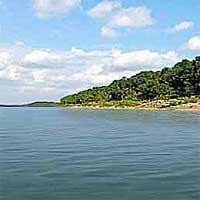
Kaw Lake is a 17,000-acre lake with 170 miles of shoreline. Crappie and blue catfish are the big draw, but the lake also has hybrid stripers, flathead and channel catfish, largemouth bass, striped bass, bluegill, white bass, sunfish, walleye and saugeye. There are numerous areas for fishing from the bank.
Primary fish species to catch
Click images for fishing tips and details about each species.
Today's Weather & Forecast
Public Boat Launch Ramps & Landings
Click here for boat ramps.
Marinas
Click here for marinas.
Fishing License
Click here for a Oklahoma Fishing License.
Map - Fishing & Access
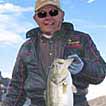
Rick Seaman is a fishing enthusiast with over five decades of fishing experience, a retired tournament fisherman, author of numerous published articles on fishing, and co-author of the book "Bass Fishing - It's not WHAT you throw, It's WHERE you throw it".
Contact Information
Sandbur RV Park - Kaw Lake
13444 OK-11
Kaw City, OK 74641
580 761-5140
Fishing lakes in each state
082125
Kaw Lake, Oklahoma Report
OKLAHOMA


Information about fishing lakes in Oklahoma
Great crappie and blue catfish fishing, plus fishing for largemouth bass, striped bass, hybrid stripers, and more in north-central Oklahoma.


